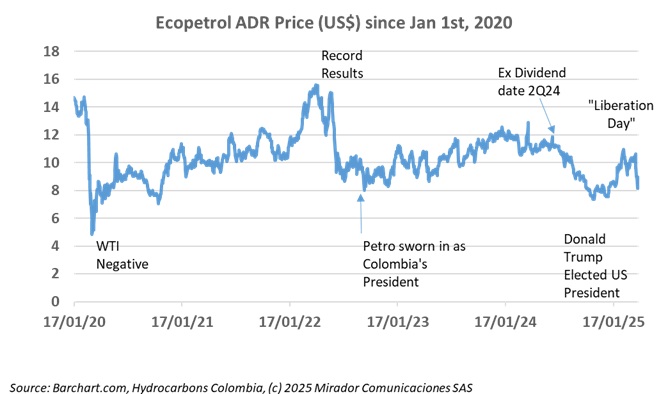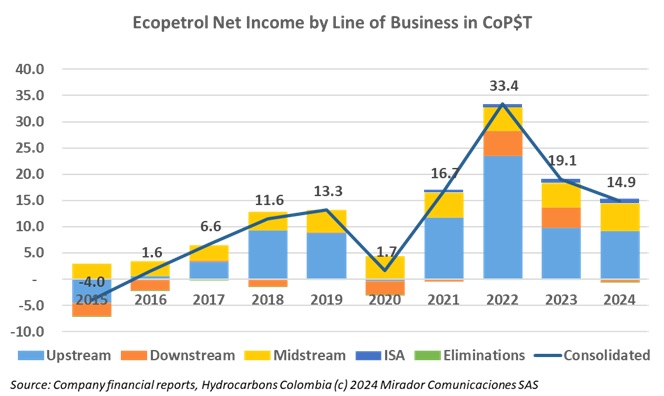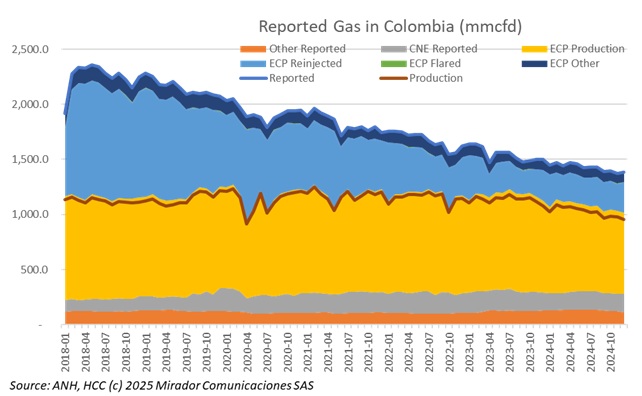
Another fall in Ecopetrol’s earnings, more handwringing and more questions about the Petro government’s handling of the country’s most important economic asset. This time, someone even tried floating a rumor that CEO Ricardo Roa would step down after the board meeting.
This week a “potpourri” of varied, vaguely related small notes that, together, turn into a commentary on the state of the Colombian hydrocarbons industry.

Although next week we should start seeing 1Q25 results, we are just getting around to our summary of 2024 Average Realized Oil Prices, Netbacks and other operating key indicators for the Colombian industry. Brent was down slightly (3%) last year so what could we hope for in netback?
MinEnergia Edwin Palma says the Colombian government will write long-term gas import contracts because “Those increases in gas prices across the country must be reversed.” He is either misguided or misleading Colombians. We hope it is the former. Gas prices appear to be on the upswing and Colombians will pay a premium to eliminate the risk of gas prices going up.

Since Donald Trump became President of the United States on January 20th, 2025 –really since he was elected in early November, 2024 – global stock markets have been on a magic carpet ride, from the highs of expectations of market-driven policies to the lows of fears of a tariff-war induced global depression. Share prices of oil and gas producers have ridden the same magic carpet, with Colombian companies pulled along by the same forces.
Earlier this year, León Valencia and his Peace and Reconciliation Foundation (Pares) published an evaluation of President Gustavo Petro’s “Total Peace” initiative, supposedly at the two-year mark of his mandate. Much of the study, ¿Plomo es lo que viene? was completely out of date by the time it hit the bookstores. (For those with the patience to make it to the end of the article, a question for our readers.)

Bloomberg recently showed a chart tracking the mentions of the word “uncertainty” in articles about trade. It has spiked dramatically since the 20th of January of this year, sending the stock market into a tailspin. Concerns about oil demand have depressed prices. Will (should?) E&Ps be revising their CAPEX plans?

Ecopetrol published its 2024 results on March 14th – almost the Ides of March – showing yet another decline in earnings (nearly 8%). The Colombian press was full of “sturm und drang” about the sorry state of the National Treasure and anticipating a rocky time at the upcoming shareholders’ general assembly over the lowered dividend. Much as we criticize the NOC strategically, we do not find this financial handwringing entirely fair.
For years, our editorial point of view was that importing gas was an unacceptable and unnecessary loss of energy sovereignty. We opposed building a second regas facility on the Pacific coast saying that the resources should be directed to encouraging domestic gas development. But, now, pragmatism means we have to modify our position.

The ANH has published detailed gas production results for 2024 and we can now see who the “winners and losers” were. We also look at MinEnergia’s recent statements that “there is enough gas”, with no need for imports.